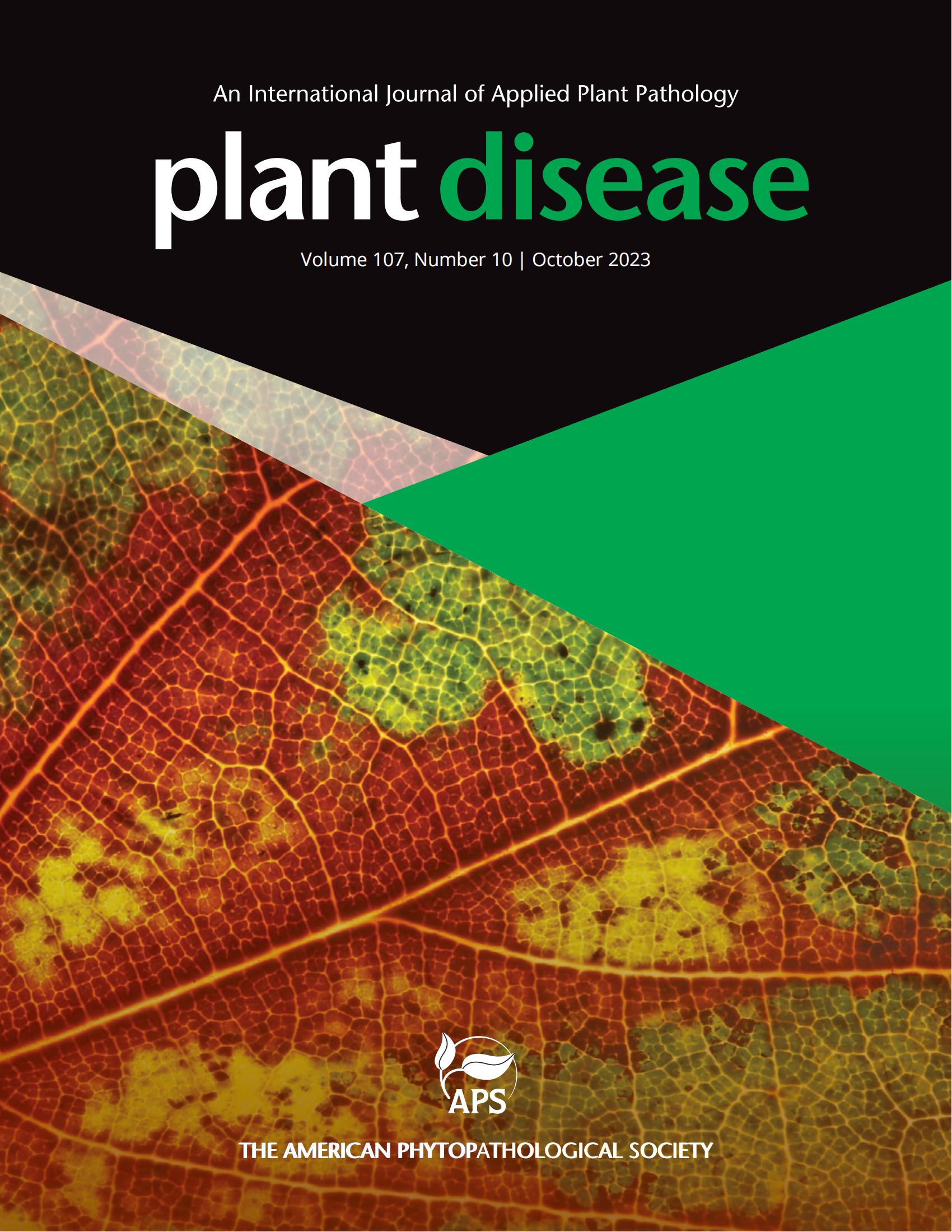糖黄单胞菌在美国引起水稻细菌性穗叶枯病的首次报道。
摘要
2023年夏季,在美国路易斯安那州的4个田间小区观察并收集了表现出严重叶枯病和穗枯病症状的水稻(Oryza sativa)。由于观察到的症状看起来像是由Pantoea ananatis (Bruno et al. 2025)或由Burkholderia glumae和B. gladioli (Nandakumar et al. 2009)引起的细菌性叶枯病和穗枯病,我们推测试图分离出其中一种细菌性病原体作为致病剂。从有症状的种子中分离细菌,表面消毒,去皮,用无菌研钵和杵在无菌蒸馏水中研磨。将匀浆铺在CCNT培养基(Kawaradani et al. 2000)和LB琼脂上,添加呋喃妥英(50µg/ml)和环己亚胺(50µg/ml)。41℃孵育72小时后,CCNT和LB琼脂板上均出现圆形、光滑和微弱的黄色细菌菌落。出乎意料的是,所有从水稻样品中分离出来的6株细菌最初都是基于pcr扩增的16S rDNA序列,使用引物fD1 (5'- ccgaattcgtcgacaacagagtttgatcctggctag -3')/rD1 (3'-CCCGGGATCCAAGCTTAAGGAGGTGATCCAGCC-5') (Weisburg et al. 1991),而不管它们的采样位置如何。使用Oxford Nanopore sequencer和Illumina NextSeq2000系统(Plasmidsaurus Inc., California, USA)的混合测序方法进行的全基因组测序分析(NCBI登录ID: PRJNA1223440)进一步证实了所有6株菌株都属于糖糖X.。为了满足Koch的假设,6个菌株LXP-1780、LXP-1783、LXP-1790、LXP-1791、LXP-1792和LXP-1793分别通过1月龄植株(cv。北竹)分蘖期;1)用无菌牙签与LB琼脂上过夜培养的细菌(每个尖端约5-8 × 105个细菌细胞)接触刺穿茎部,2)用剪刀将叶子夹在含有约1 × 108个细菌细胞/ mL无菌蒸馏水的菌悬液中。以无菌蒸馏水接种的水稻植株为阴性对照,进行2次毒力测定,每株3次重复。接种后第27天,接种植株的叶片和穗部出现症状,与田间最初观察到的症状相似。除叶枯病和水浸病外,观察到的最明显的症状是叶尖发黑或变黑,表现为黑斑或黑条。在穗上,观察到穗枯病样症状,如籽粒变色和稻壳变黑。从每株人工接种的植株中重新分离出细菌,并验证了它们的身份是糖精X.。据我们所知,这是美国首次报道由糖糜虫引起的水稻病害。这一发现强烈表明,这种疾病的出现是对美国水稻产业的一个新的潜在威胁。此外,本研究获得的糖糖双歧杆菌菌株及其全基因组序列信息将为今后对该新发疾病的研究奠定基础。Rice (Oryza sativa) plants showing severe leaf and panicle blight symptoms were observed and collected from four field plots in Louisiana in summer 2023. As the observed symptoms looked like bacterial leaf and panicle blight caused by Pantoea ananatis (Bruno et al. 2025) or bacterial panicle blight caused by Burkholderia glumae and B. gladioli (Nandakumar et al. 2009), we presumptively attempted to isolate one of these bacterial pathogens as the causal agent. Bacteria were isolated from the symptomatic seeds, which were surface sterilized, dehulled and ground in sterile distilled water using a sterile mortar and pestle. The homogenate was spread on the CCNT medium (Kawaradani et al. 2000) and LB agar supplemented with nitrofurantoin (50 µg/ml) and cycloheximide (50 µg/ml). After 72 h incubation at 41⁰C, round, smooth and faint, yellow-colored bacterial colonies appeared on both CCNT and LB agar plates. Unexpectedly, all six bacterial isolates from rice samples were initially identified as Xanthomonas sacchari based on PCR-amplified 16S rDNA sequences using the primers fD1 (5'-CCGAATTCGTCGACAACAGAGTTTGATCCTGGCTCAG-3')/rD1 (3'-CCCGGGATCCAAGCTTAAGGAGGTGATCCAGCC-5') (Weisburg et al. 1991), regardless of their sampling locations. Whole genome sequencing analyses (NCBI Accession ID: PRJNA1223440) performed through a hybrid sequencing approach using Oxford Nanopore sequencer & Illumina NextSeq2000 system (Plasmidsaurus Inc., California, USA) further confirmed that all six strains belong to X. sacchari. To satisfy Koch's postulates, each of the six strains LXP-1780, LXP-1783, LXP-1790, LXP-1791, LXP-1792, and LXP-1793 was confirmed for its pathogenicity to rice through two inoculation methods, using one-month-old plants (cv. Kitaake) at tillering stage; 1) pricking the stems with a sterile toothpick touched to the overnight grown bacterial culture on LB agar (~ 5-8 x 105 bacterial cells per tip) and 2) clipping the leaves with scissors dipped in the bacterial suspension containing ~1 × 108 bacterial cells per mL of sterile distilled water. This virulence assay was conducted twice with three replications for each strain, and rice plants inoculated with sterile distilled water were included as the negative control. By twenty-seven days after inoculation (DAI), the inoculated plants developed symptoms on leaves and panicles, which were similar to the symptoms initially observed in the field. Besides blight symptoms and water-soaked lesions in the leaves, the most noticeable symptom observed was the blackening or darkening of the leaf tips, which appeared as dark spots or streaks. In panicles, panicle blight-like symptoms, such as grain discoloration and darkening of rice hulls, were observed. The bacteria were reisolated from each artificially inoculated plant and their identity were validated to be X. sacchari. To our knowledge, this is the first report of rice disease caused by X. sacchari in the United States. This finding strongly suggests the emergence of this disease as a new potential threat to U.S. rice industry. Furthermore, the strains of X. sacchari and their whole genome sequence information obtained from this study will serve as a foundation for future studies on this newly emerging disease.

 求助内容:
求助内容: 应助结果提醒方式:
应助结果提醒方式:


